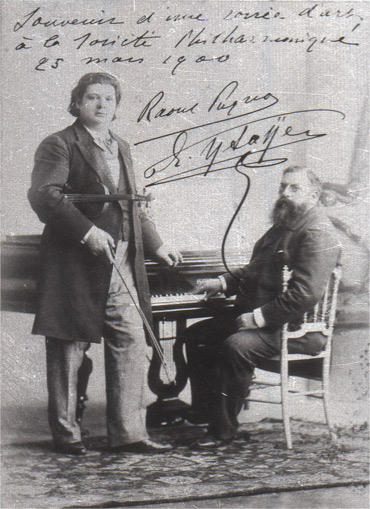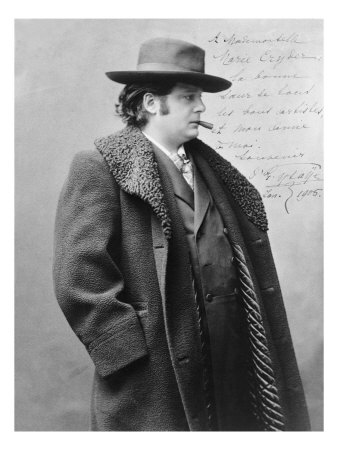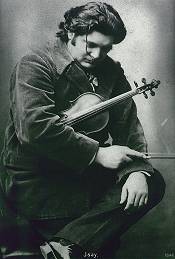<Back to Index>
- Inventor John Kay, 1704
- Composer Eugène Ysaÿe, 1858
- Supreme Allied Commander, Europe General Bernard William Rogers, 1921
PAGE SPONSOR
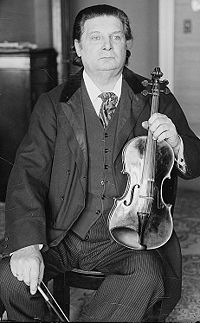
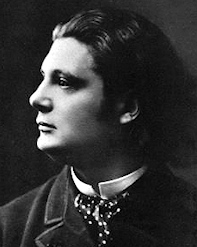
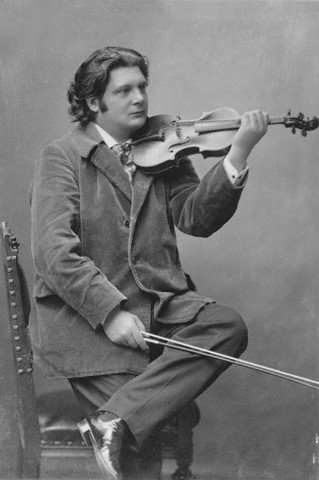
Eugène Ysaÿe (16 July 1858 – 12 May 1931) was a Belgian violinist, composer and conductor born in Liège. He was regarded as "The King of the Violin", or, as Nathan Milstein put it, the "tzar". His brother was pianist and composer Théo Ysaÿe (1865 – 1918), and his great - grandson is Marc Ysaÿe, drummer of rock band Machiavel.
Eugène - Auguste Ysaÿe came from a background of peasants, though a large part of his family played instruments. As violinist Arnold Steinhardt describes, a legend was passed down through the Ysaÿe family about the first violin brought to the lineage:
It was told of a boy whom some woodcutters found in the forest and brought to the village. The boy grew up to be a blacksmith. Once, at a village festival, he astonished everyone by playing the viol beautifully. From then on the villagers took pleasure in dancing and singing to the strains of his viol. One day an illustrious stranger stopped in front of the smithy to have his horse shod. The count's servant saw the viol inside and told the young smith that he had heard a new Italian instrument played by some minstrels at the count's court. That instrument, called the violin, was much better than the viol – its tone was like the human voice and could express every feeling and passion. From that moment the young man no longer took pleasure in his viol. Day and night he was thinking of that wonderful new instrument that could express joy and sorrow and whose tones went straight to the human heart. Then he had a dream: he saw before him a young woman of indescribable beauty, not unlike his own love, Bienthline. She came to him and kissed his brow. The young man awoke and looked at the wall his broken and neglected viol used to hang on and could barely believe his eyes: there, instead of the viol, was a new instrument of beautiful proportions. He put it against his shoulder and drew the bow over the strings, producing sounds that were truly divine. The violin sang in a heartwarming tone: it rejoiced and wept for happiness – and so did the musician. Thus, goes the legend, came the first violin to the Ardennes and to the Ysaÿe family.
Born in Liège, Belgium, Ysaÿe began violin lessons
at age five with his father. He would later recognize his father's
teaching as the foundation of everything he knew on his instrument,
even though he went on to study with highly reputed masters. At seven
he entered the Conservatoire at Liège studying with Joseph Massart,
though soon afterwards he was asked to leave the conservatory because
of lack of progress. This was because, in order to support his family,
young Eugène had to play full time in two local orchestras, one
conducted by his father. Eugène went on playing in these
ensembles, though he studied by himself and learned the repertoire of
the violin. By the time he was twelve, he was playing so well that one
day he was practicing in a cellar when the legendary Henri Vieuxtemps,
passing in the street, was so impressed with the sound of his violin
that he took an interest in the boy. He arranged for Ysaÿe to be
re-admitted to the conservatory studying with Vieuxtemps's assistant,
the noted Henryk Wieniawski.
Ysaÿe would later also study with Vieuxtemps, and both "master and
disciple", as Ysaÿe would call the roles of teacher and pupil,
were very fond of each other. In his last years, Vieuxtemps asked
Ysaÿe to come to the countryside just to play for him. Studying
with these teachers meant that he was part of the so-called
Franco - Belgian school of violin playing, which dates back to the
development of the modern violin bow by François Tourte.
Qualities of this "École" included elegance, a full tone with a
sense of drawing a "long" bow with no jerks, precise left hand
techniques, and bowing using the whole forearm while keeping both the
wrist and upper arm quiet (as opposed to Joseph Joachim's German school of wrist bowing and Leopold Auer's Russian concept of using the whole arm.) After his graduation from the Royal Conservatory of Liège, Ysaÿe was the principal violin of the Benjamin Bilse beer hall orchestra, which later developed into the Berlin Philharmonic. Many musicians of note and influence came regularly to hear this orchestra and Ysaÿe in particular, among whom figured Joseph Joachim, Franz Liszt, Clara Schumann, and Anton Rubinstein, who asked that Ysaÿe be released from his contract to accompany him on tour. When Ysaÿe was twenty - seven years old, he was recommended as a soloist for one of the Concerts Colonne in
Paris, which was the start of his great success as a concert artist.
The next year, Ysaÿe received a professorship at the Brussels Conservatoire in
his native Belgium. This began his career as a teacher, which was to
remain one of his main occupations after leaving the Conservatoire in
1898 and into his last years. Among his more respected pupils are Josef Gingold, former concert master of the Cleveland Orchestra and Professor at Indiana University, the viola virtuoso William Primrose, the violin virtuoso Nathan Milstein (who primarily studied with Pyotr Stolyarsky), Louis Persinger, Alberto Bachmann, Mathieu Crickboom, Jonny Heykens, Charles Houdret, Jascha Brodsky, and Aldo Ferraresi. During
his tenure as professor at the Conservatoire, Ysaÿe continued to
tour an ever - broadening section of the world, including all of Europe,
Russia, and the United States. Despite health concerns, particularly
regarding the condition of his hands, Ysaÿe was at his best when
performing, and many prominent composers dedicated major works to him,
including Claude Debussy, Camille Saint - Saëns, César Franck, and Ernest Chausson. In particular, mention should be made of Franck's Violin Sonata in A,
written as a wedding present for Ysaÿe and his wife in 1886, which
Ysaÿe played wherever he went for the rest of his life. In 1886 he established the Ysaÿe Quartet, which premiered Debussy's String Quartet. As
his physical ailments grew more prohibitive, Ysaÿe turned more to
teaching, conducting and an early love, composition. Among his most
famous works are the six Sonatas for Solo Violin op. 27, the unaccompanied Sonata for Cello, op. 28, one Sonata for Two Violins, eight Poèmes for various instruments (one or two violins, violin and cello, string quartet) and orchestra (Poème élégiaque, Poème de l'Extase, Chant d'hiver, Poème nocturne, among others), pieces for string orchestra without basses (including Poème de l'Exil), two string trios, a quintet, and an opera, Peter the Miner, written near the end of his life in the Walloon dialect. Ysaÿe had been offered the post of music director of the New York Philharmonic in 1898, but declined it due to his busy solo performance schedule. In 1918, he accepted the music director's position with the Cincinnati Symphony Orchestra, where he remained until 1922 and with which he made several recordings. Finally, in 1931, suffering from the extreme ravages of diabetes that
had necessitated the amputation of his left foot, Eugène
Ysaÿe died in his house in Brussels and was interred in the Ixelles Cemetery in Brussels. As a performer, Ysaÿe was compelling and highly original. Pablo Casals claimed never to have heard a violinist play in tune before Ysaÿe, and Carl Flesch called him "the most outstanding and individual violinist I have ever heard in my life." Ysaÿe possessed a large and flexible tone, influenced by a considerable variety of vibrato — from no vibrato at all to very intense. He said, "Don't always vibrate, but always be vibrating". His modus operandi was, in his own words: "Nothing which wouldn't have for goal emotion, poetry, heart." Possibly the most distinctive feature of Ysaÿe's interpretations was his masterful rubato. Conductor Sir Henry Woodsaid,
"Whenever he stole time from one note, he faithfully paid it back
within four bars", allowing his accompanist to maintain strict tempo
under his free cantilena. Incidentally, this kind of rubato fits the
description of Frédéric Chopin's rubato. Although Ysaÿe was a great interpreter of late Romantic and early modern composers — Max Bruch, Camille Saint - Saëns, and César Franck, who said he was their greatest interpreter — he was admired for his Bach and Beethoven interpretations.
His technique was brilliant and finely honed, and in this respect he is
the first modern violinist, whose technique was without the shortcomings of some earlier artists. An international violin competition in Brussels was created in his memory: in 1951, this became the violin section of the Queen Elisabeth Music Competition. Ysaÿe
was married twice. His first marrriage, on 29 September 1886, was to
Louise Bourdeau de Coutrai, with whom he had three sons.César Franck presented his Violin Sonata in A to
them as a gift on the morning of the wedding, and after a hurried
rehearsal Ysaÿe performed the piece at the marriage celebration. The sonata had its formal concert premiere in December 1886. After
Louise's death in 1924 he married a pupil of his, Jeanette Dincin, 44
years his junior. She was a violinist who in her teens had studied with
prominent teachers such as Franz Kneisel, Leopold Auer, and Otakar Ševčík.
Ysaÿe met her in 1922 while conductor of the Cincinnati Orchestra.
She cared for him in his ailing years. Eugene's only request of her
after he died was that she carry on her performances under his name. Eugène Ysaÿe was also close friends with Queen Elisabeth of Belgium,
whom he taught violin despite her lack of talent. His widow took over
the royal teaching herself after his death, and the queen began the
competition in his honor. Ysaÿe was also a friend of Claude Debussy and would sometimes correspond to him by letter. The
two had great respect for each other and Ysaÿe was a significant
supporter of the younger composer's early career. Debussy dedicated his
only string quartet to the violinist who took great care in studying the score. The
quartet received its premiere on December 29, 1893 by the Ysaÿe
Quartet at the Société Nationale in Paris but to mixed
reviews. The virtuoso and the composer also corresponded during the
writing of Debussy's Nocturnes.
